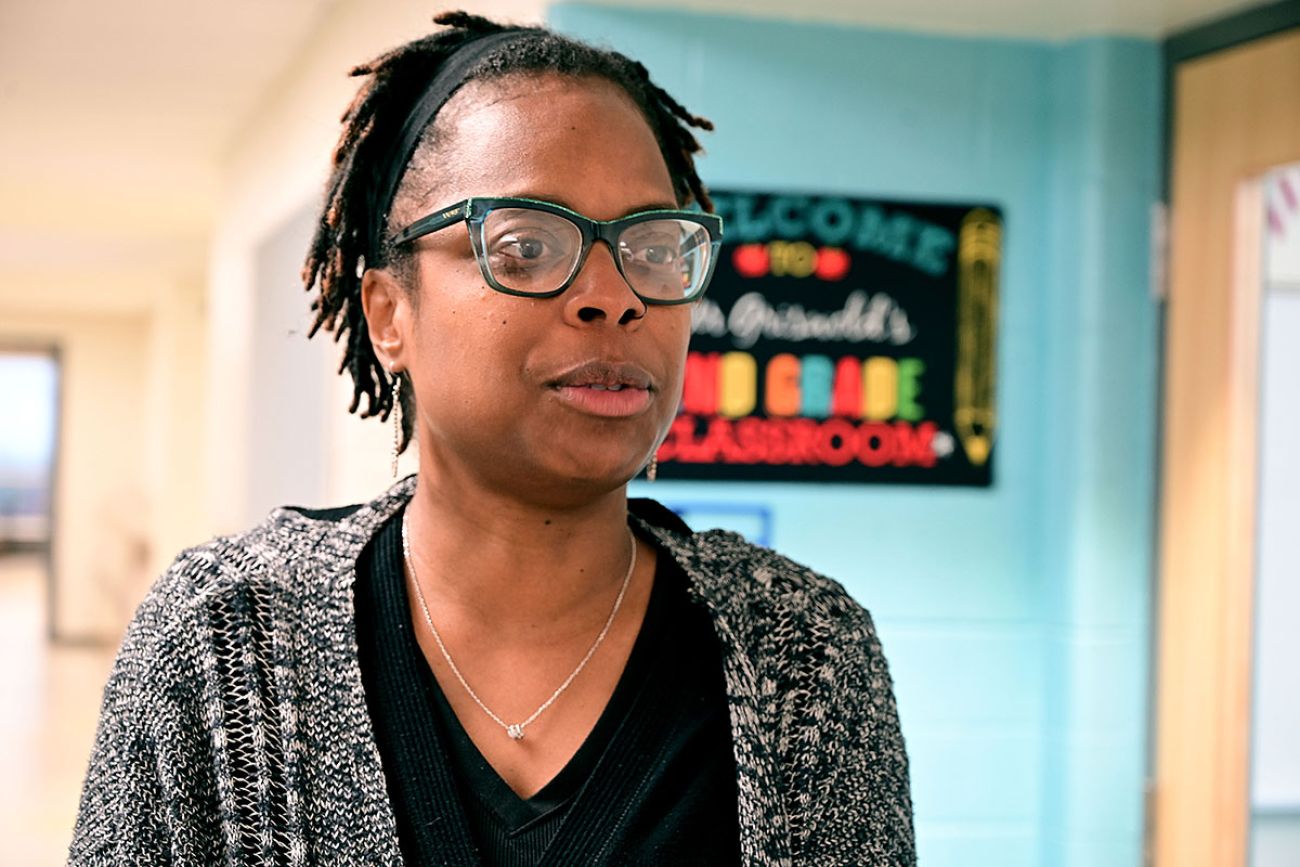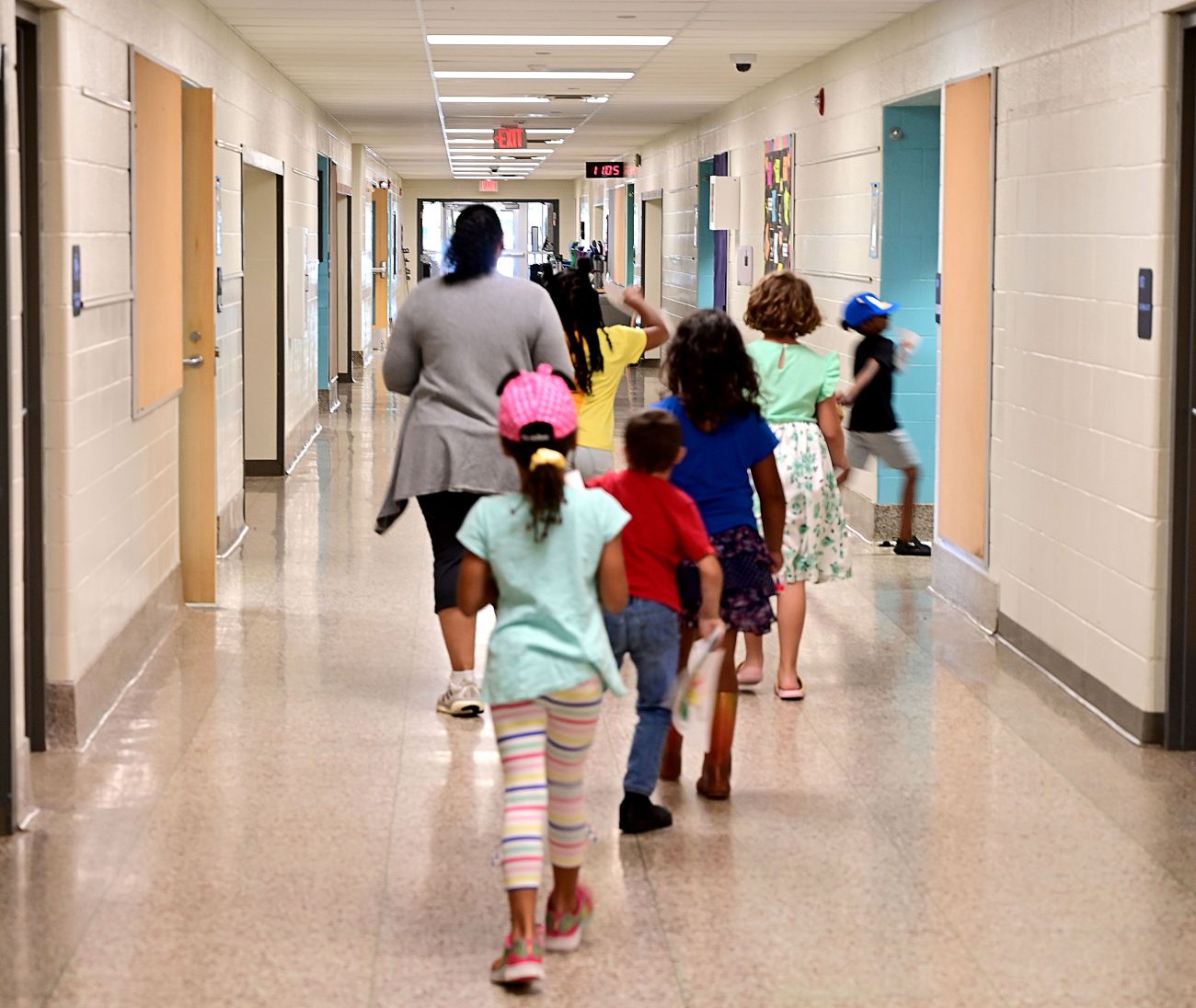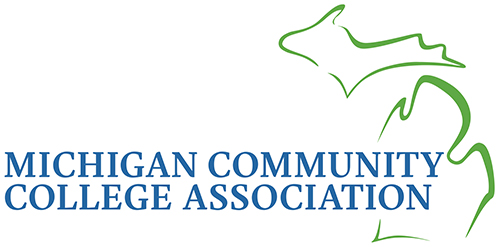Michigan schools on hiring spree. Can it reverse ‘Titanic’ learning losses?
- Staffing at public schools jumped 14% in the past 10 years, while enrollment dropped 9%
- Most new hires are classroom aides; test scores are still down or flat
- Supporters say the strategy needs time to work; others are skeptical
LANSING — Veteran teacher Hayley Gaines noticed something different the past few years at Pattengill Biotechnical Magnet School in Lansing.
More staffers, especially paraprofessionals, assisting with special education and early-education students.
“When I started here (10 years ago) parapros were a rare thing,” said Gaines, who teaches middle school English as a Second Language classes at the K-8 school. “Now they’ve brought more people in for reading intervention. The teachers and students really appreciate it.”
Michigan schools are on a hiring spree. A Bridge Michigan analysis of state data reveals the number of administrators, teachers and aides working in public schools jumped almost 14% in the past decade, even while enrollment dropped 9%.
The flood of extra bodies is among efforts to address Michigan’s learning crisis, which has seen the state slide to 44th in the nation in fourth grade reading scores, according to the National Assessment of Educational Progress (NAEP). Michigan has also increased education spending dramatically and toggled between policy reforms searching for answers.
So far, nothing has worked — and education advocates say it may take years to see progress, even as patience runs thin.
“We’re trying to turn around a goddamn Titanic here,” said Sen. Dayna Polehanki, D-Livonia, a former teacher and chair of the Senate Education Committee. “It takes a little time.”
The biggest share of those additional school employees is not teachers or administrators, but aides like the ones Gaines sees in the hallways of her school, at least some of whom have been thrown into the battle to improve early literacy. Statewide, there were nearly 21,000 more aides in public schools in 2024 than a decade earlier. At Gaines’ district, staffing was up 7.3% in that time, while enrollment declined 12.5%
Whether the extra personnel can do what a series of on-again, off-again reforms has failed to accomplish isn’t clear; third-grade reading scores on the state’s M-STEP standardized assessment and fourth-grade scores on the NAEP remain flat or have dropped despite the employee expansion.
Three-quarters of Michigan districts have added staff in the past decade, while English proficiency rates for third- and eighth-graders have fallen in 83% of districts, according to Bridge’s analysis.
The money spent on additional staff raises questions for Tom Leonard, former Republican speaker of the House and current candidate for governor. Leonard wondered how many of the new staffers help with the vital work of improving early literacy, and how many were adding to “administrative bureaucracy."
“More money doesn’t always translate into better outcomes,” Leonard told Bridge. “We’ve got to spend money more wisely.”
While test scores haven’t risen with employment, educators point to better student behavior and academic growth on internal assessments as indicators that the extra staff is making a difference. Some of the additional workers are mandated by law to assist a growing proportion of students with special needs.
State Rep. Regina Weiss, D-Oak Park, said that while “we’re way far away” from Michigan being the best state for education, “we could have potentially actually (been) in a much worse place” without the extra staff.
“It’s going to take consistency and stability and sustainability and predictability,” said Weiss, who is a former teacher. “And unfortunately, that’s not the political environment that we’re living in right now.”
More adults for fewer students
Michigan has tried and then dropped numerous education reforms aimed at improving the state’s flailing early literacy rates.
That matters because studies show third-graders who struggle to read have lower academic achievement in high school, which can lead to fewer attending college. Incomes generally rise with education. In Michigan, the typical high school graduate earns $31,900 a year five years after graduation; those with a postsecondary certificate or associate’s degree bring home about $54,000; those with a bachelor’s degree, $65,000.
Michigan education crisis
Despite more money, more staffing and years of attempted reforms, Michigan schools are sliding farther behind other states in key educational outcomes. One Michigan education leader called it a “moment of reckoning,” and many candidates who have announced plans to run for governor in 2026 are making education reform a key to their campaigns.
Throughout 2025, Bridge Michigan will chronicle how we reached this crisis point, the impact of our learning slide, and what we can learn from other states.
During the past decade, the number of teachers statewide increased 2%, and administrators 6%. The biggest chunk of additional staff were aides, rising 28%.
Increased staffing has occurred without public fanfare or a mandate out of Lansing, but rather through discretionary spending by districts across the state.
At Rochester Community School District, the number of full-time equivalent positions for aides jumped 140% between 2014-15 and 2023-24; Battle Creek Public Schools rose 110% and Grand Blanc Community Schools grew its number of aides by 97%.
Educators like Alena Zachery-Ross, superintendent at Ypsilanti Community Schools, where staffing is up 14.2%, say additional staff play a vital role in their schools.
“We know that we’re still combating some of the aftermath” of the pandemic, Zachery-Ross said. “The district is still doing a lot of intervention to help students get on track from the academic freefall that occurred during the pandemic.”
The increase in aides could be partly explained by an increase in English language learners and special education students. Statewide, there are 13,000 more students with disabilities than a year ago, and the percentage of special education students statewide has risen to 15% from 13%.
In Ypsilanti, the district’s English language learner population has nearly doubled since the 2019-20 school year, which requires more staffing. Assistant Superintendent Carlos Lopez said there were about 12 employees working with ESL students five years ago. Now, he estimates the district has about 50 employees working with those students.
Related:
- School district lookup: How scores, staff, enrollment changed across Michigan
- Here’s how governor candidates say they’d fix Michigan education
- Mississippi turned around its schools. Its secret: Tools Michigan abandoned
- Fact check: What’s true, false, misleading about Michigan’s education slide
- Michigan spent big to fix schools. The result: Worse scores and plenty of blame
Zachery-Ross said teaching is “more complex than ever,” and “we have to keep the smaller class sizes because they have so many more diverse needs in these classrooms today than even a few years ago.”
Tara Kilbride, associate director of the Education Policy Innovation Collaborative at Michigan State University, cautioned the hiring trends are “more nuanced than just adding more staff and test scores going up or down,” and quantity doesn’t always equal quality.
School leaders are “struggling to find the types of people who they really need,” Kilbride said, so may be triaging by picking the people they can find. Veteran teachers are leaving at high rates, and the state is at an “all-time” high for the number of teachers with a temporary credential.
Among the new staffers is aide Ashley Harris, who on a recent summer morning was working with an autistic child in a second-grade classroom in Lansing’s Pattengill school.

Harris has an associate’s degree in horticulture, but has always wanted to work with children, and is taking online courses to someday become a teacher.
“It’s helpful for the kids to have another person in the class,” she said. “I help them focus.”
Value of highly qualified educators
Whether Michigan is spending its money wisely is yet to be determined. Studies are mixed on whether additional support staff increases learning. And on the state level, test scores haven’t jumped since staffing began to rise.
Craig Thiel, research director at Lansing-based Citizens Research Council of Michigan, said extra people won’t necessarily improve learning. Studies show that the No. 1 determinant of student learning is the quality of classroom teachers.
“There’s an argument that money could be invested in the current staff to make them more productive,” Thiel said. That would involve performance-based pay or sizable teacher bonuses for high academic performance of students.
The average school building in Michigan has seven more staffers today than a decade ago.

Those extra helping hands could improve teacher morale in a time where the state struggles to retain its teachers. One study found that teachers value access to special education specialists, counselors and nurses more than a 10% raise in salary.
“What you’re seeing from this data is both this true belief that getting high-qualified educators into the classroom is the single most important thing you could do to move students toward success,” said Lansing Superintendent Ben Shuldiner.
“But also understanding that the rates of special education have gone up inextricably over the last decade, and with that is a lot more need for individuals, especially aides and paras, to be in the classroom.”
M-STEP scores in Shuldiner’s district are up between 2022 and 2024, chronic absenteeism has dropped and graduation rates are up.
“In this four-year window while I’ve been superintendent, we find that this money is well spent.”
That formula is working at Whitmore Lake Public Schools, where aide staffing is up 50% and English and math proficiency is up too. Superintendent Tom DeKeyser said the district added aides for its Montessori pre-K program, special education programming and in general education classrooms where there were a large share of students behind academically.
“We tell our school board all the time we’ve added a lot of parapro support but we’re feeling like we’re just now at a point we should have been a while ago,” he said.
Budget worries
A decade ago, there was one school staffer for every 8.5 students; now, there’s a staffer for every seven.
That hiring spree could be coming to an end before data determines if it’s successful. The potential loss of federal funds that are tied to low-income students could lead to staffing cuts that are more likely to target aides than teachers.
Adding to the uncertainty is Michigan’s inability to finalize a state school budget. Lawmakers typically complete one by July 1, when school districts’ new fiscal year starts.
But the Republican-led House and Democrat-led Senate have not reached a deal and blew past a deadline written in state law to get a budget done.
Michigan Schools Superintendent Michael Rice said the state has invested $1.1 billion over the past three years to train teachers and replace those who are retiring. He said the strategy needs time to work and called on lawmakers to maintain the funding.
"These dollars will help rebuild the profession over the next half decade; however, it takes time for prospective teachers to complete their education and for those teachers to become experienced educators," Rice said.
Michigan Education Watch
Michigan Education Watch is made possible by generous financial support from:
Subscribe to Michigan Education Watch
See what new members are saying about why they donated to Bridge Michigan:
- “In order for this information to be accurate and unbiased it must be underwritten by its readers, not by special interests.” - Larry S.
- “Not many other media sources report on the topics Bridge does.” - Susan B.
- “Your journalism is outstanding and rare these days.” - Mark S.
If you want to ensure the future of nonpartisan, nonprofit Michigan journalism, please become a member today. You, too, will be asked why you donated and maybe we'll feature your quote next time!






